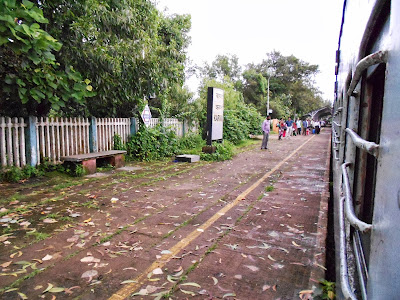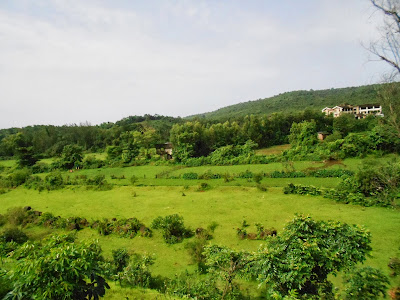Riding the Konkan Railway has been a long awaited event. Moreover, I have always imagined that riding the Konkan Railway during the monsoon would probably be even more of a spectacular sight.
The route covers close to 750 km across three states, connecting India's commercial capital Mumbai with the port city of Mangalore, with about 60 stations in between, crossing numerous bridges small and big, and snaking its way via several man-made tunnels bored through the rugged Western Ghats mountains. Constructing the Konkan Railway system was a massive engineering feat. Keeping the trains, tracks, resources, logistics, power supply and IT systems running in the midst of power failures, torrential rains, lightning strikes, landslides and other similar unpredictable natural calamities deserves a big salute.
True enough, the recent heavy rains seemed to have washed the area clean and green.
My journey began in Bangalore. The overnight bus is the most convenient mode of transport that gets you into Madgaon early in the morning.
The monsoons have been heavy this year, damaging several roads. However, we got into Madgaon by 6:30 AM, as expected. A few passengers got off the bus. A clutch of 3-wheeled auto-rickshaws and motorbike taxis welcomed us warmly in Goan style, huddled in water-proof jackets and raincoats. I looked up nervously at the clouds. Will it? Won't it?
The motorbike taxis are quite unique to Goa. The drivers are called 'pilots'. One of the 'pilots' offered to ferry me across to the side entrance of Madgaon Railway Station for Rs 40. He said that the ride to the main entrance would be worth Rs 60 since it involves a detour. I hopped aboard, and away we went along the still moist streets of Madgaon.
Madgaon station was just about to wake up. A few newspaper and vada-pav sellers were parked outside by the entrance of the ramp. The ramp and over-bridge sheltered the usual handful of passengers who sleep over, and the homeless folks with their homeless pet dogs for company.
The first thing to do was to buy my ticket. Finding my way to the ticket counter at the front entrance of the station was no trouble. Only a handful of passengers had shown up at the booking counter by then. The folks who had sought shelter overnight, and their temporary pets, were still fast asleep.
I bought a ticket in the unreserved, 2-class coach up to Kudal. Wow, I thought, looking down at the ticket in my hand. Two hours, 140 km, Rs 55, not too bad.
The numerous train names and numbers on the board was confusing. A quick check with a railway official was enough to clear the fog, and to ask about the location of the my coach.
In a few minutes I was near the three 2-class unreserved coaches at the back of the train. Which one do I board? Well, how about the one in the middle? I happened to be the first to board the recently washed coach, and had the pleasure of choosing my seat and opening all the windows around me.
There were very few passengers that morning. One of them appeared hesitatingly friendly, and was thrilled when I photographed him.
Next, it was his turn. I gave him a few camera lessons in Hindi which I hoped he would understand. He kept nodding, and was terribly excited, and very lost. It appeared as if that was the first time he was using a camera. He did a pretty good job after a few tries. He even came over and waved goodbye when he got off at one of the stations.
Two toots happened simultaneously at 08:30 AM. The toot of the engine and the toot of a nearby factory. I was pleasantly surprised at the punctuality of the train. And we were off, very slowly at first. We passed the well worn out and partly rusted station sign board.
Fasten your seat belts, sit back, and enjoy the ride.
Before we left, I was busy making sure that all the windows around me were open. I was close to the doors, as well. That meant several vantage points. The ride to Kudal was going to take two hours, with a few short stops in between.
The sight of the mighty Zuari river looking very turbulent and brown from churned mud was a welcome sight, though this time I was staring at the road bridge from the railway bridge. Soon we were on the tiny bridge that goes above the highway that we have driven on so often while going to and from the airport. Same place, different perspectives.
Pretty little stations passed by, like Karmali, Thivim and others. Karmali platform were still moist from the overnight rain, and the winds had caused leaves to fall. I guess the cleaners had not arrived yet.
Building the Konkan Railway has been a mammoth task. Several tunnels needed to be bored, dark and moist. On some occasions, my camera and glasses were splashed with water flowing down through the rocks. Many little streams passed quickly by, resulting in blurred photos.
The train snaked by lovely countryside with cool air, looking and feeling even prettier after the rains.
We went over numerous rivers under grey skies. The rivers certainly appeared to be swollen after the recent deluge of the monsoon rains.
The paddy fields were lush and green. And quite wet. One farmer appeared to be interested in our trip.
Gosh! Do you see that? Am I seeing what I think I am seeing? Is that a bit of sunlight appearing? Yes, that is right, that is indeed right. A tiny bit of blue sky has also shyly peeped out from behind the threatening clouds.
Here comes the sun.
The train stopped at a station, and it was time to celebrate by attempting a few potentially award-winning photographs. After all, I had bought the tiny point-and-shoot camera only a few hours before leaving home, so I needed some practice. While I was not at the right angle to catch the glint of the sun that had struggled to free itself from behind the clouds, but did manage to catch a bit of the contrast of light and shadow. That was my small way of welcoming the sun. It was almost imperceptibly getting very slightly brighter.
Can you tell a green field from a cold steel rail?
There was a flurry of activity when the train stopped at Sawantwadi station. Many passengers got on and off the train. A passenger got in and parked herself across the aisle. Her posture was interesting. She probably suspected that I was up to no good with my camera, so shielded her face most of the time. Hooking the "sari" with the toes appeared to be a well practiced, effective, anti-wind and anti-wardrobe malfunction measure.
The green fields with patches of water sped by. The bars on the windows started to reflect some sunlight along the way.
Finally, it was time to get off. Once again, the train was on time. It was time to find my way to my next port of call.
Thanks for joining me on my much awaited ride on the Konkan Railway. I do hope you enjoyed the ride as much as I did.
Next stop, Nivati port and fishing village.
-=-=-=-=
Posts in this series:
Monsoon Washed Konkan Railway
Nivati fishing village
The Net fisherman of Vengurla
Redi Red and Shiroda White sand beach
Shiroda to Panaji at 10:30 AM
Calangute and Baga during the Monsoons
SJBHS OBA Connect 2013 Goa
-=-=-=-=
























You enjoyed lots
ReplyDeleteBut I must say the once you visit Tarkarli beach It is world famous white sand beach in India
This comment has been removed by the author.
ReplyDeleteThe Konkan Railway line which runs along the konkan coast of India, between Mumbai and Mangluru. Best Railway and best place.
ReplyDeleteHi, I agree with you. Really this blog is very informative.
ReplyDeleteirctc login sign up